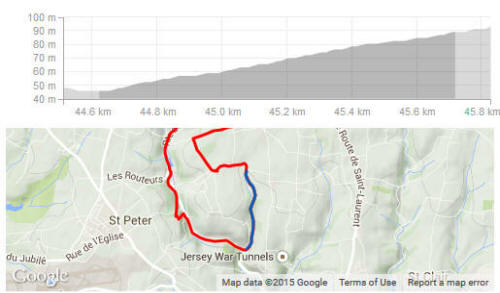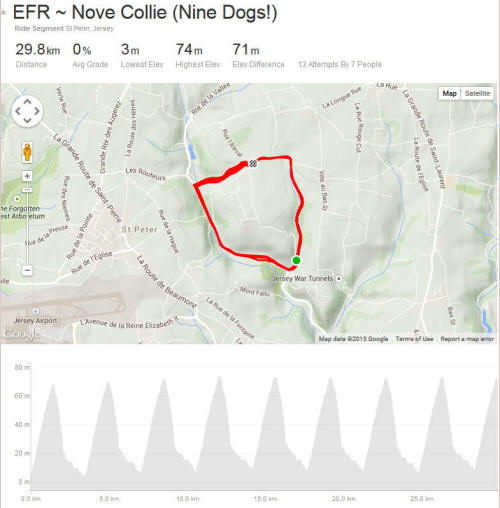Building Strength
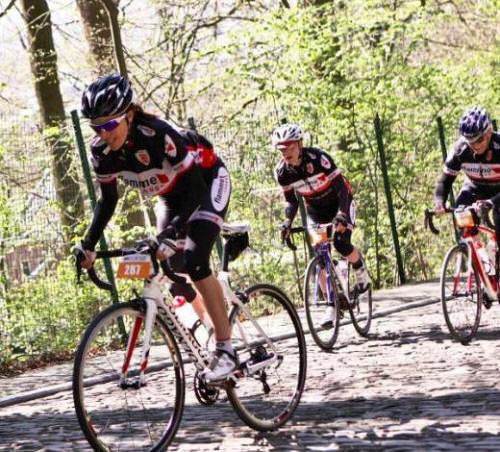
The mighty Muur de Geraardsbergen ~ this picture makes it look flat!
Susan Clark, leading Pete Slattery and Simon Perchard
Bike riders often, and understandably, confuse strength with power. Although they are closely related, they are not the same.
Once you grasp the difference between the two, and how they can help you, training for specific climbing or sprinting objectives becomes a whole new and exciting ball game!
Watt is Power?
Let's gloss over the imperious wordsmith-ness of the title and move
on to what power actually is. First a formula; oh I do love a
formula...
P = F x V
Power is "simply" the product of force times speed. Force is, for the purpose of understanding the reason behind this factsheet, strength.
Power (P), is what drives the bike forward, it's measured in watts.
Force (F), how hard you push on the pedals, is measured in Newtons.
Speed (V for velocity) is, in this case, the travelling speed of the pedal, measured in metres per second.
There is an old saying in the motor racing world; "power sells engines, torque wins races" That's why we're going to look at building "torque" to give it it's technical name, "strength" to give it its practical one.
Looking at the formula above, you can see that if we keep leg speed the same and increase force, then power will rise proportionately .
If we keep force the same, and increase leg speed, then (again) power will rise proportionately.
But if we increase force AND leg speed, then power will rise exponentially!
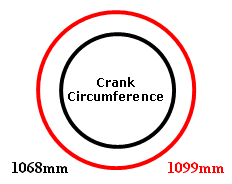 Don't Ignore Leg
Speed
Don't Ignore Leg
Speed
Here
you can see the circumference patterns of two crank sets and the
distance they travel for one revolution.
The black 170 mm crank covers 1068 mm per revolution.
The red 175 crank covers 1099 mm.
Unsurprisingly, the
"standard"
172.5, sits in the middle!
This is why it's important to know your crank length, as it has a direct relationship with leg speed and subsequently power output.
To increase power you have three options...
▼ press harder on the pedals (strength)
▼ turn the pedals faster (cadence)
▼ or a combination of the two
If you want to increase power you can push with the same force but turn the pedals faster. This "normally" puts higher demands on your cardio respiratory system.
Or, you can hoyck it up a gear, drop your revs, and push harder on the pedals. This "normally" places a higher demand on your muscular system.
One is more subtle than the other, but both can prove equally effective in the right circumstances.
Being able to do either one of these two will make you a better rider and bring PB's. If you can do both, it could make you a champion.
We've dealt with leg speed elsewhere, so for now, we're going to look at how to improve muscular strength.
Close But No Cigar
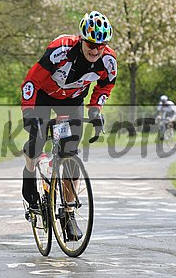 I
see many, many, many riders going out and doing hill reps to try and build
leg strength. And of course many of them do; eventually.
I
see many, many, many riders going out and doing hill reps to try and build
leg strength. And of course many of them do; eventually.
Their intentions are good, their work rate is excellent and their endevour will eventually be rewarded. But it takes time.
Most riders tackle hills one of two ways. They do the same hill many times over, riding it until exhaustion. They then, to create a perceived overload, try to crack out one more rep than they did last time.
They get more and more tired as the session goes on and normally it's just their iron will that gets them over the last climb.
Which is what's happening to me here, on the mighty La Redoute at the end of the Liege Bastogne Liege sportive!
The quality of their last efforts are questionable as (due to fatigue) it becomes impossible to produce the increased force required to create an adaptation. Form and technique go out the window and this becomes the time when riders are most susceptible to a debilitating muscular injury.
The other option used, is to find a hill and ride up it a small-ish gear. They then drop back to the start, knock it up a gear, then go again. The objective being to go a little further, or do one more climb than last week's session.
As above, this repeats itself until near exhaustion and a slow ride home. Once more the last efforts become questionable as form and technique become compromised. Injury potential, as ever, lurks in the periphery.
The two options above are perceived as good workouts. Physical overload has been achieved, tiredness has set in, and they all get home thinking "I've done a session there". But what has actually been gained?
Fatigue, stamina endorphins, and endurance potential have probably been raised; with possibly a stretched hamstring or tweaked back muscle.
Physical overload has been achieved, but not a physiological one! What most definitely hasn't been gained, is strength.
There is another way.
Suffer Well...
Your attitude towards a difficult task will
ultimately determine its
outcome. Cliché alert ~If you think you can, you can;
if you think you can't, you won't!
This is a hard session, otherwise what's the point(?), but it is rewarding and it is quick to bring those rewards. So get your mind right before you go out on these sessions.
You will suffer; but paradoxically, you will suffer less than in the sessions I've just outlined. But above all else, you will get stronger, quicker, and you will lessen fatigue and injury potential. What's not to like?

The only climb I've ever had to stop on!
1900 metres @ AVERAGE 17%
Muur di Sormano ~ Fabio
Casartelli Sportive (Lombardy)
photo ~ gruber images
First off find a hill! But not the one above!
You need a "consistent" 4% to 5% hill of three to four minutes, about a kilometre long. The key point is consistency of slope; we use a climb called the German Road, which sits alongside our infamous War Tunnels.
As you can see, there is little variation in pitch from bottom to top. Try to find something similar for your efforts.
The Session
 After
a "proper" warm up, of at least fifteen to twenty minutes, approach
the climb.
After
a "proper" warm up, of at least fifteen to twenty minutes, approach
the climb.
Get yourself in the big ring (whatever it is for you) and your next but top (hardest) gear. Be it a 12, 13 or whatever.
If you aren't really sure what you can do, go out and do a recce ride before the session and do a single attempt in say a 14 as a "tester".
However you manage (good or bad), just adjust your starting point for the session proper.
Without risking strain or injury, get yourself up the climb in your self-selected starting gear.
Hold your core steady, and if you have to get out of the saddle, so be it.
If you can do a loop, like we can, so much the better. If not, you turn around, drop back down slowly to recover, then get ready to go again.
On your way to the bottom, take a sip of drink, let your heart rate drop, and change down a gear (make it a gear easier!).
This way, you can keep count as to how many efforts you've done, or more importantly, can see at a glance how many there are to go!
Repeat this action until you get to the top of your block and the easiest gear. Depending on your gearing (and where you started), that will be eight, nine or ten climbs.
Unlike the previous examples of sessions, there is an almost 100% chance you will complete this session! Only boredom should prevent you!
As you get further in to the session the effort actually requires less strength but doesn't get any easier as leg speed and lactate begin to build in equal measure.
Why it Works
The beauty, and genius, of this session (once it's pointed out) is
the obvious
advantages it brings.
When you start, you are "fresh" and have the ability to push a big gear, thereby allowing you to build strength.
As the session draws on, the strength requirements are lessened (they're already in the bank) and the emphasis moves to leg speed.
In the way described earlier, the way most people do these efforts, the rider actually gets more fatigued as the session progresses. They get to the hard gears at the end of their session and they are then too fatigued to be able to push the pedals with the required force.
So they go home tired, drawn and not much stronger.
This way, you build strength at the beginning of the session and develop leg speed and lactate tolerance at the end of it. You then get to ride home with "loose" legs, a warm glow of satisfaction and an overall feeling of a "good job, well done".
Once you are able to "spring" up the climb, just change your starting gear or go the full ten or eleven gears, depending on your availability.
Once you can "out-climb the climb", just go and find a slightly longer, slightly steeper, or slightly cobbled hill. Sorted...
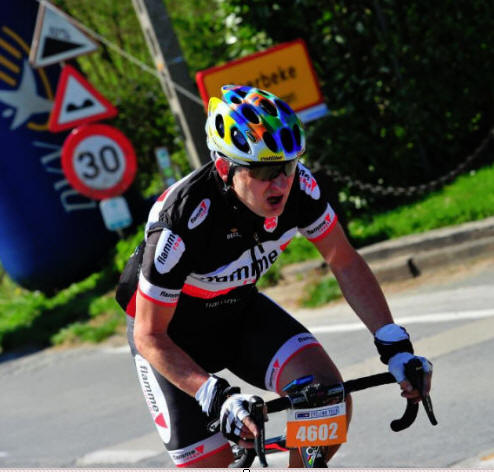
The Bosberg ~ strength builder extrordinare...
The Message
You can't build strength when you are tired; it just doesn't happen
that way. You need to change your approach and do the strength
stuff when you're strong.
Sprinting or climbing, it's all the same. It's the person that can press on the pedals the hardest, or the fastest that wins the race. It's the person that can do both, that wins the championship.
This is a brilliant session because it allows you to do both. Give it a try; what's the worst that can happen?
As for the German Road? Here's a video of me descending it, you really shouldn't try at home...
Suffer Well, Get Strong, Have Fun...

